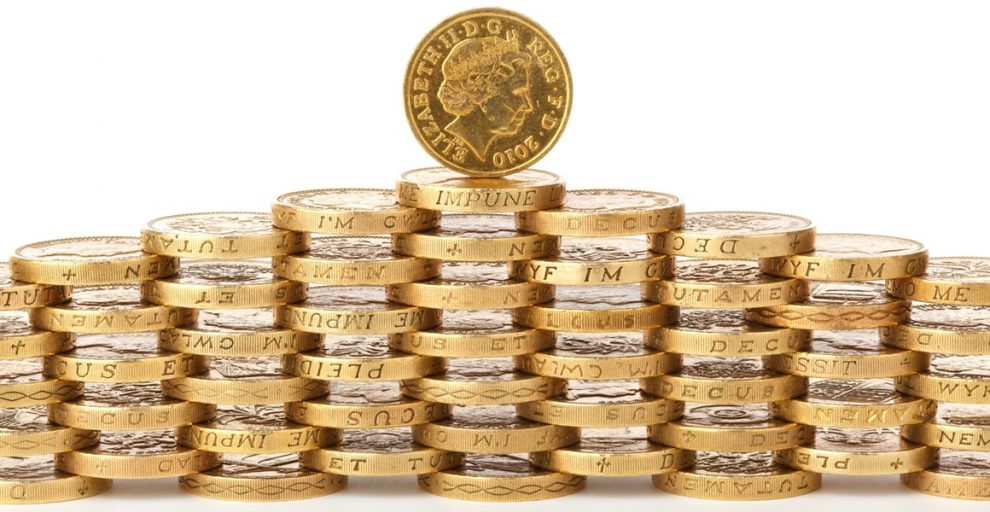Exchange daily course between USA Dollars (USD) and British Pounds (GBP) is given on this page.
In first drop down menu choose British Pounds (GBP). In second choose USA Dollars (USD). If you enter 1 British Pounds (GBP) for example, you will receive its equivalent in Dollars, Euros, Dinars, Japanese Jean, Rubles etc.
You can enter any arbitrary amount of currencies below. Rates are updated daily by Swiss National Bank.
Date: Monday 31st of March 2025 06:37:46 PM
Currency converter calculators for USA Dollars (USD) to British Pounds (GBP) today currency exchange ratio:
British Pounds (GBP)
The pound sterling (symbol: £; ISO code: GBP), often simply called the pound, is the currency of the United Kingdom, its Crown dependencies (the Isle of Man and the Channel Islands) and the British Overseas Territories of South Georgia and the South Sandwich Islands and British Antarctic Territory. It is subdivided into 100 pence(singular: penny).
The Gibraltar pound, Falkland Islands pound and Saint Helena pound are separate currencies, pegged to the pound sterling. Sterling is the third-largest reserve currency, after the US dollar and the euro. The pound sterling is also the fourth-most-traded currency in the foreign exchange market after the US dollar, the euro, and the Japanese yen.
The pound and euro fluctuate in value against one another, although there may be correlation between movements in their respective exchange rates with other currencies such as the US dollar. Inflation concerns in the UK led the Bank of England to raise interest rates in late 2006 and 2007. This caused the pound to appreciate against other major currencies, and with the US dollar depreciating at the same time, the pound hit a 15-year high against the US dollar on 18 April 2007, having reached US$2 for the first time since 1992 the day before.
The pound and many other currencies continued to appreciate against the dollar, and sterling hit a 26-year high of $2.1161 on 7 November 2007 as the dollar fell worldwide.
From mid-2003 to mid 2007, the pound/euro rate remained rangebound (within ± 5% of) €1.45. However, since the global financial crisis in late 2008, the pound has since depreciated at one of the fastest rates in the history, reaching a 24-year low of $1.35 per £1 on January 23, 2009 and falling below €1.25 against the euro in April 2008. A further decline was seen during the remainder of 2008; most dramatically in December when its euro rate hit an all-time low at €1.0219 (29/12). The pound appreciated in early 2009 reaching a peak in mid July of €1.17. The following months have seen a steady decline, with the pound’s current(Oct ’09) value at €1.09 and USD$1.63.
Banknotes of British Pounds (GBP)
The first sterling notes were issued by the Bank of England shortly after its foundation in 1694. Denominations were initially written on the notes at the time of issue. From 1745, the notes were printed in denominations between £20 and £1000, with any odd shillings added in hand. £10 notes were added in 1759, followed by £5 in 1793 and £1 and £2 in 1797. The lowest two denominations were withdrawn following the end of the Napoleonic wars. In 1855, the notes were converted to being entirely printed, with denominations of £5, £10, £20, £50, £100, £200, £300, £500 and £1000 issued.
A £20 note of the 2007 issue from the Bank Of ScotlandThe Bank of Scotland began issuing notes in 1695. Although the pound scots was still the currency of Scotland, these notes were denominated in sterling in values up to £100. From 1727, the Royal Bank of Scotland also issued notes. Both banks issued some notes denominated in guineas as well as pounds. In the 19th century, regulations limited the smallest note issued by Scottish banks to be the £1 denomination, a note not permitted in England.
With the extension of sterling to Ireland in 1825, the Bank of Ireland began issuing sterling notes, later followed by other Irish banks. These notes included the unusual denominations of 30/- and £3. The highest denomination issued by the Irish banks was £100.
In 1826, banks at least 65 miles (105 km) from London were given permission to issue their own paper money. From 1844, new banks were excluded from issuing notes in England and Wales but not in Scotland and Ireland. Consequently, the number of private banknotes dwindled in England and Wales but proliferated in Scotland and Ireland. The last English private banknotes were issued in 1921.
In 1914, the Treasury introduced notes for 10/- and £1 to replace gold coins. These circulated until 1928, when they were replaced by Bank of England notes. Irish independence reduced the number of Irish banks issuing sterling notes to five operating in Northern Ireland. The Second World War had a drastic effect on the note production of the Bank of England. Fearful of mass forgery by the Nazis (see Operation Bernhard), all notes for £10 and above ceased production, leaving the bank to issue only 10/-, £1 and £5 notes. Scottish and Northern Irish issues were unaffected, with issues in denominations of £1, £5, £10, £20, £50 and £100.
The Bank of England reintroduced £10 notes in 1964. In 1969, the 10/-note was replaced by the 50p coin as part of the preparation for decimalisation. £20 Bank of England notes were reintroduced in 1970, followed by £50 in 1982. Following the introduction of the £1 coin in 1983, Bank of England £1 notes were withdrawn in 1988. Scottish and Northern Irish banks followed, with only the Royal Bank of Scotland continuing to issue this denomination.
The £5 polymer banknote, issued by Northern Bank in 2000, is the only polymer note currently in circulation, although Northern Bank also produces paper-based £10, £20 and £50 notes.
in 2007, a commemorative George Best £5 note was issued by Ulster Bank. These notes were limited edition and many were presented in frames from the Ulster Bank Head Office in Belfast. These notes are rarely seen in circulation. If you are in Capital of Britain, for a good choice of hotels with discount prices, visit Hotel in London for more information.
Recommendation
-
Recommendation
















Its gold Elizabeth 11